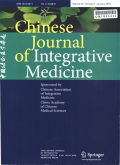- 钛学术文献服务平台 \
- 学术期刊 \
- 医药卫生期刊 \
- 中国医学期刊 \
- 中国结合医学杂志(英文版)期刊 \
null
Acupoint Catgut Embedding Alleviates Insomnia in Different Chinese Medicine Syndrome Types:A Randomized Controlled Trial
基本信息来源于合作网站,原文需代理用户跳转至来源网站获取
摘要:
Objective:To investigate the effects and safety of catgut embedding on alleviating insomnia.Methods:Totally 510 patients with insomnia were divided into 5 Chinese medicine (CM) syndrome types:Xin (Heart) and Pi (Spleen) deficiency,yin deficiency with excess fire,Xin and gut qi deficiency,Wei (Stomach) disorder,and qi and blood deficiency,respectively.These 5 types of patients were randomly assigned to a catgut embedding group,an acupuncture group or a medication group (30 cases in Xin and Pi deficiency type,Wei disorder type,Xin and gut qi deficiency type,respectively;40 cases in yin deficiency with excess fire type and qi and blood deficiency type,respectively).In the catgut embedding group,patients were treated by implanting catgut into acupoints once every 10 days for a total of 30 days.In the acupuncture group,patients were treated with acupuncture once per day over 30 days (excluding weekends);and patients in the medication group took 1 mg Eurodin Tablet orally every night for 30 days.Pittsburgh Sleep Quality Index (PSQI) was evaluated before treatment,on 30 and 60 days after the first treatment,respectively.The International Unified Sleep Efficiency Value (IUSEV) was measured at 30 and 60 days.The safety was evaluated after treatment and adverse events were analyzed.Results:The objective PSQI scores including subjective sleep quality,sleep latency,sleep duration,habitual sleep efficiency,sleep disturbance,daytime dysfunction,and total scores at 30 days were significantly improved compared with pre-treatment in the catgut embedding and acupuncture groups (P<0.01 or P<0.05).At 30 days,the PSQI scores in catgut embedding group were superior to the medication group in the patients with each type of insomnia,with the exception of sleep duration (P<0.01 or P<0.05).At 60 days,significant differences were found between the catgut embedding group and the medication group (P<0.01 for all indices).The IUSEV scores in the catgut embedding group were significantly higher than the acupuncture group at 60 days,and the scores in acupuncture group were higher than the medication group at 30 days (P<0.05 for all types).No severe adverse events were found in this study.Conclusions:Acupoint catgut embedding and acupuncture were more effective than medication in alleviating insomnia syndrome in different Chinese medicine syndrome type.However,the sustained effects of acupoint catgut embedding were superior to acupuncture.

推荐文章
期刊_丙丁烷TDLAS测量系统的吸收峰自动检测
带间级联激光器
调谐半导体激光吸收光谱
雾剂检漏 中红外吸收峰 洛伦兹光谱线型
不同盐度、温度及光照对漂浮浒苔生理生态的影响
浒苔
盐度
温度
光照
生理生态
期刊_联合空间信息的改进低秩稀疏矩阵分解的高光谱异常目标检测
高光谱图像
异常目标检测 低秩稀疏矩阵分解 稀疏矩阵 残差矩阵
内容分析
关键词云
关键词热度
相关文献总数
(/次)
(/年)
文献信息
| 篇名 | Acupoint Catgut Embedding Alleviates Insomnia in Different Chinese Medicine Syndrome Types:A Randomized Controlled Trial | ||
| 来源期刊 | 中国结合医学杂志(英文版) | 学科 | |
| 关键词 | |||
| 年,卷(期) | 2019,(7) | 所属期刊栏目 | |
| 研究方向 | 页码范围 | 543-549 | |
| 页数 | 7页 | 分类号 | |
| 字数 | 语种 | 英文 | |
| DOI | 10.1007/s11655-018-2770-3 | ||
五维指标
引文网络
引文网络
二级参考文献 (89)
共引文献 (100)
参考文献 (14)
节点文献
引证文献 (0)
同被引文献 (0)
二级引证文献 (0)
1985(1)
- 参考文献(0)
- 二级参考文献(1)
1989(1)
- 参考文献(1)
- 二级参考文献(0)
1993(1)
- 参考文献(0)
- 二级参考文献(1)
1995(2)
- 参考文献(0)
- 二级参考文献(2)
1996(3)
- 参考文献(0)
- 二级参考文献(3)
1997(3)
- 参考文献(0)
- 二级参考文献(3)
1998(7)
- 参考文献(0)
- 二级参考文献(7)
1999(3)
- 参考文献(0)
- 二级参考文献(3)
2000(3)
- 参考文献(1)
- 二级参考文献(2)
2001(3)
- 参考文献(0)
- 二级参考文献(3)
2002(4)
- 参考文献(0)
- 二级参考文献(4)
2003(11)
- 参考文献(1)
- 二级参考文献(10)
2004(4)
- 参考文献(0)
- 二级参考文献(4)
2005(7)
- 参考文献(0)
- 二级参考文献(7)
2006(4)
- 参考文献(0)
- 二级参考文献(4)
2007(3)
- 参考文献(1)
- 二级参考文献(2)
2008(3)
- 参考文献(0)
- 二级参考文献(3)
2009(6)
- 参考文献(1)
- 二级参考文献(5)
2010(2)
- 参考文献(1)
- 二级参考文献(1)
2011(5)
- 参考文献(1)
- 二级参考文献(4)
2012(5)
- 参考文献(0)
- 二级参考文献(5)
2013(4)
- 参考文献(0)
- 二级参考文献(4)
2014(8)
- 参考文献(1)
- 二级参考文献(7)
2015(7)
- 参考文献(3)
- 二级参考文献(4)
2016(2)
- 参考文献(2)
- 二级参考文献(0)
2017(1)
- 参考文献(1)
- 二级参考文献(0)
2019(0)
- 参考文献(0)
- 二级参考文献(0)
- 引证文献(0)
- 二级引证文献(0)
引文网络交叉学科
相关学者/机构
期刊影响力
中国结合医学杂志(英文版)
主办单位:
中国中西医结合学会
中国中医研究院
出版周期:
月刊
ISSN:
1672-0415
CN:
11-4928/R
开本:
大16开
出版地:
北京西苑操场1号
邮发代号:
82-825
创刊时间:
1995
语种:
eng
出版文献量(篇)
2643
总下载数(次)
0
总被引数(次)
8415
期刊文献
相关文献
推荐文献
- 期刊分类
- 期刊(年)
- 期刊(期)
- 期刊推荐
中国结合医学杂志(英文版)2022
中国结合医学杂志(英文版)2021
中国结合医学杂志(英文版)2020
中国结合医学杂志(英文版)2019
中国结合医学杂志(英文版)2018
中国结合医学杂志(英文版)2017
中国结合医学杂志(英文版)2016
中国结合医学杂志(英文版)2015
中国结合医学杂志(英文版)2014
中国结合医学杂志(英文版)2013
中国结合医学杂志(英文版)2012
中国结合医学杂志(英文版)2011
中国结合医学杂志(英文版)2010
中国结合医学杂志(英文版)2009
中国结合医学杂志(英文版)2008
中国结合医学杂志(英文版)2007
中国结合医学杂志(英文版)2006
中国结合医学杂志(英文版)2005
中国结合医学杂志(英文版)2004
中国结合医学杂志(英文版)2003
中国结合医学杂志(英文版)2002
中国结合医学杂志(英文版)2001
中国结合医学杂志(英文版)2000
中国结合医学杂志(英文版)1999
中国结合医学杂志(英文版)1998
中国结合医学杂志(英文版)2019年第9期
中国结合医学杂志(英文版)2019年第8期
中国结合医学杂志(英文版)2019年第7期
中国结合医学杂志(英文版)2019年第6期
中国结合医学杂志(英文版)2019年第5期
中国结合医学杂志(英文版)2019年第4期
中国结合医学杂志(英文版)2019年第3期
中国结合医学杂志(英文版)2019年第2期
中国结合医学杂志(英文版)2019年第12期
中国结合医学杂志(英文版)2019年第11期
中国结合医学杂志(英文版)2019年第10期
中国结合医学杂志(英文版)2019年第1期

 免费查重
免费查重










